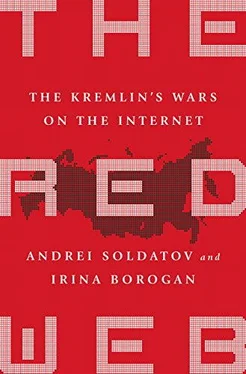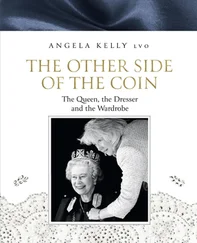In six months Andrei wrote his first lengthy feature. The story was about how Oracle databases were acquired at Lubyanka, the FSB headquarters. Andrei’s contacts told him that Oracle technologies, which were subject to export restrictions in the United States (Oracle’s CEO, Larry Ellison, once famously said that the Russians would take Oracle only in missile warheads), were sold to the FSB to build a huge database on terrorists. An outraged FSB officer called the newspaper before the publication, trying to kill the story. But nobody paid attention to his threats, and the story made the front page.
One day Irina went to the editor-in-chief and asked to be transferred to the crime department of the paper. The astonished editor tried to talk her out of it: the crime department was not the most prestigious unit in the newspaper. He suggested instead that she move to the political department, but Irina persisted; she thought it was the best place to get journalistic experience. Indeed it was.
On the fifth floor of the offices of Segodnya there was a large room with a radio scanner on the windowsill, always turned on to listen to a police frequency. A dozen people hung around day and night, among them a former KGB officer, an ex-policeman, and a pair of sixteen-year-olds. One of them was brought to the newspaper by his father, a policeman, who was troubled by his son’s criminal mindset. The boy turned out to have a talent for crime reporting. Parkhomenko’s son also landed briefly in the room. Some of the reporters often signed their stories by pseudonyms, and several people shared some of the pseudonyms to make the identification more difficult: the department received calls from angry policemen and “businessmen” with clear criminal connections almost on a daily basis.
In the 1990s these reporters not only wrote about crime but also did the work of the investigative departments: they covered the high-profile assassinations of businessmen and politicians, wrote about secret services, and were sent to the North Caucasus to cover hostage dramas. Within a year Andrei followed Irina to the crime department, where the reporters had developed a camaraderie and helped each other in sometimes very tough circumstances.
In these years journalists had power, and we felt it in our work. But journalism also suffered from a lack of restraint and established ethical standards. The nascent public relations industry often attempted to bribe journalists, promising money for publishing false or sometimes genuinely compromising information about high-placed officials and prominent businessmen. A mix of intercepted phone calls and analytical profiles prepared by the oligarchs’ shadowy security branches or the government security services became known as kompromat , or compromising materials. What made it all even more confusing was that sometimes journalists willingly acted as mercenaries for various interests or loyal members of the oligarchic business structures. Russian security services carried out surveillance and intercepted phone calls, selling their findings as part of kompromat. The resulting articles effectively influenced the public.
The editorial offices battled frantically with this corrupt journalism. Kommersant installed a special department called “rewrite” (in English), tasked to edit heavily—that is, rewrite—every piece submitted by staff journalists for publication to filter out any zakaz , or information that had been paid for by a special interest. Segodnya had a former officer of the Fifth Directorate of the KGB who in Soviet times was in charge of persecuting dissidents; now he checked suspicious articles after publication. If he concluded a story was unfair, the journalist was fired. [15] Based on authors’ conversation with an officer who was put in charge of “supervising” Segodnya .
In the mid-1990s the flow of information in media was free but could also be confusing for readers. The oligarchs used their news media outlets as weapons to fight for control of the nation’s vast resources. Around the same time, by 1996, the Russian Internet was undergoing explosive growth. The first search engine, Rambler.ru, appeared, and the first political party website was established for Yabloko, and Interfax news agency launched its own website. Internet advertising became a paying business, drawing real revenue. It was a new, fashionable business that caught the Russian oligarchs’ attention. Boris Berezovsky, one of those who helped secure Yeltsin’s victory in the presidential elections, underwrote a new Internet service provider, Cityline, whose managers were the first to grasp that people came to the Internet because of the actual content they could find there. Cityline helped launch a handful of online media and content projects, ranging from magazines to blogs.
In December a thirty-year-old Internet activist, Anton Nossik, started a new project, a daily online column called Vecherny Internet , or the Evening Internet , which was hosted on Cityline. The project was launched from Israel, as Nossik, born to a prominent Moscow intelligentsia family, had emigrated to Israel in 1990 and became prominent in the Russian and Israeli Internet communities.
Nossik soon realized that the new Internet media could trump the traditional journalism. He believed people would embrace information presented on the Internet, as it would be available sooner, more accessible, and brief. Less concerned about gathering the information, his sought to emphasize the form, not the substance. He wanted to repackage news from traditional print media and deliver it to Internet users quickly. It was an early kernel of what became the news aggregator, and it would define the Russian Internet for the next decade. Riding the wave of the Evening Internet ’s success, Nossik returned to Moscow in March 1997.
The Evening Internet became the very first blog in Russia.
In the vast apparatus of the Russian government one group of officials began to pay close attention to this new online activity. The security services were among the first to conclude that it should be controlled.
In 1998 the diminutive Vika Egorova was a twenty-six-year-old editor at an obscure magazine. She had studied at the Moscow Engineering and Physics Institute, a preeminent school for training nuclear scientists, and had an interest in mathematics. After graduating, she worked at a risk management company run by former KGB people, then was hired as an editor at Mir Kartochek , or World of Credit Cards. The circulation was tiny, but Egorova’s interests ranged beyond credit cards; she began learning about secret codes and developed contacts in the world of cryptology, the science of creating and deciphering clandestine messages.
In June she received a call from one of her contacts, who worked for a small information security company. Egorova sensed the small company was related, somehow, to FAPSI, the Russian electronic intelligence agency modeled after the US National Security Agency.
Egorova knew that FAPSI was fighting the more powerful FSB, the main successor to the KGB. The intelligence services jostled with each other in a competition for power and money and especially fought for control over profitable businesses, such as encryption technology that the banks were required to buy from the secret services.
Egorova’s contact offered some information about credit card technology that might interest her magazine, so on June 10 she went to meet with him. He handed her several pages of documents, which she quickly realized had nothing to do with credit cards. It was an official document of some kind, a draft with places for signatures—still blank. But at the very top of the draft was the word soglasovano , or “approved.” [1] Vika Egorova, interview with authors, August 2014.
Читать дальше












